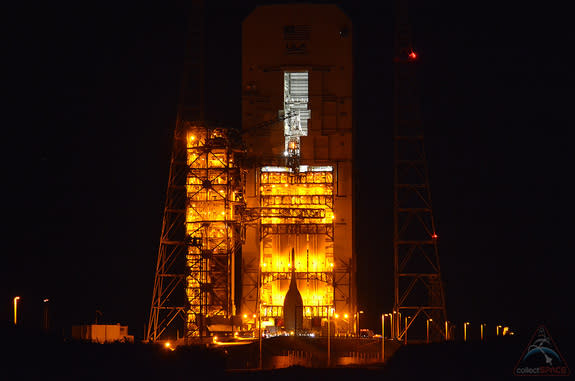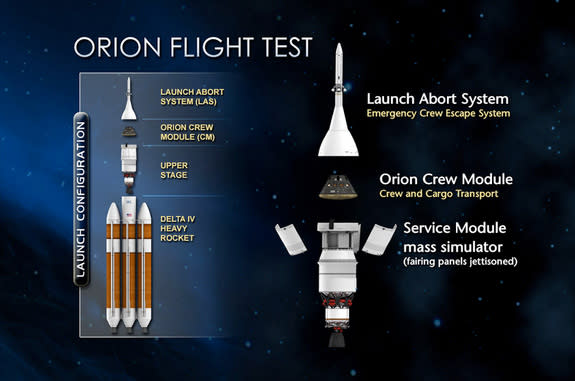Orion on the Pad: NASA Rolls Out Space Capsule for 1st Test Flight
CAPE CANAVERAL, Fla. — NASA's first space-bound Orion capsule has arrived at the launch pad, where it will lift off in early December on an uncrewed test flight in support of NASA's plans for future astronaut missions beyond Earth orbit.
The gumdrop-shaped spacecraft, encased within a white aerodynamic shell and topped by a launch escape tower, rolled up to the base of Space Launch Complex 37B at the Cape Canaveral Air Force Station in Florida at 3:07 a.m. EST (0807 GMT) on Wednesday (Nov. 12).
The capsule, which is set to embark on Dec. 4 on NASA's Exploration Flight Test-1 (EFT-1), rode out to the pad atop a multi-wheeled transporter. A banner hung on the front of the vehicle read, "Neil Armstrong Operations & Checkout Building 'I'm On Board,'" referencing the building where the spacecraft was assembled. [The Orion Capsule: NASA's Next Spaceship (Photos)]
"I gotta tell you, this is special," Bob Cabana, the director of NASA's Kennedy Space Center and a former astronaut, told reporters during a press conference on Monday (Nov. 10). "This is our first step on the journey to Mars."
"To see the vehicle on top of the service module with the launch abort system attached, it is quite a stack," Cabana continued. "And it is going to look really good on top of the Delta IV [rocket]."
The Orion's journey to the pad began on Tuesday night at 8:54 p.m. EST (0154 GMT Nov. 11) at a hangar some 22 miles (35 kilometers) away at the Kennedy Space Center.
"To see the actual vehicle, the first [Orion] that is going to fly, is an amazing sight," Rex Walheim, a NASA astronaut who flew onboard the final space shuttle mission and now represents the astronaut office in the Orion program, told collectSPACE. "It just looks beautiful and it is just so nice seeing us get a new vehicle to the launch pad."
The six-hour rollout originated at the Launch Abort System Facility, where the Orion spacecraft was equipped with its escape system tower and enveloped within its outer shell "ogive" panels.
The Exploration Flight Test-1 mission will see the in-flight separation of these components from the Orion as part of the mission's test objectives.
"EFT-1 is basically a compilation of what I would say are the riskiest events we're going to see when we fly people," Mark Geyer, NASA's Orion program manager, said during a press conference held Thursday (Nov. 6). "So this test flight is a great opportunity for us to fly those and actually see them in operation."
"Some of these [mission] events are very difficult or even impossible to test on the ground, so it is important that we fly them," Geyer continued. "EFT-1 gives us a chance to put all those together in a test flight."
On the way out to SLC-37B, the Orion paused in front of the 52-story-tall Vehicle Assembly Building, where NASA plans to assemble its Space Launch System rockets that will fly Orion on future missions out to the vicinity of the moon and eventually to Mars. The capsule also rolled past Pad 39B, where the space agency's Saturn V moon-bound rockets and space shuttles left Earth, and from where the SLS will launch.
Now at its departure site, the 72-foot-tall (22-meter) Orion, complete with its booster adapter section, will be hoisted 170 feet (52 meters) into the air and mounted to the United Launch Alliance Delta IV Heavy rocket that will launch it into Earth orbit. The EFT-1 mission is scheduled to lift off Dec. 4 at 7:05 a.m. EST (1205 GMT), just after sunrise.
The flight test will take the Orion 15 times farther out into space than the International Space Station on a four-and-a-half-hour mission to test many of the systems critical for human missions into deep space. After circling the planet twice, the Orion will reenter Earth's atmosphere at 20,000 miles per hour before descending under parachutes to a splashdown in the Pacific Ocean.
Click through to collectSPACE for more photos of NASA’s first space-bound Orion capsule rolling out to the launch pad.
Follow collectSPACE.com on Facebook and on Twitter at @collectSPACE. Copyright 2014 collectSPACE.com. All rights reserved.
Photos: NASA's Space Exploration Vehicle for Asteroids & Beyond
Orion Spacecraft Moved To Fueling Facility | Time-Lapse Video
Copyright 2014 SPACE.com, a TechMediaNetwork company. All rights reserved. This material may not be published, broadcast, rewritten or redistributed.


